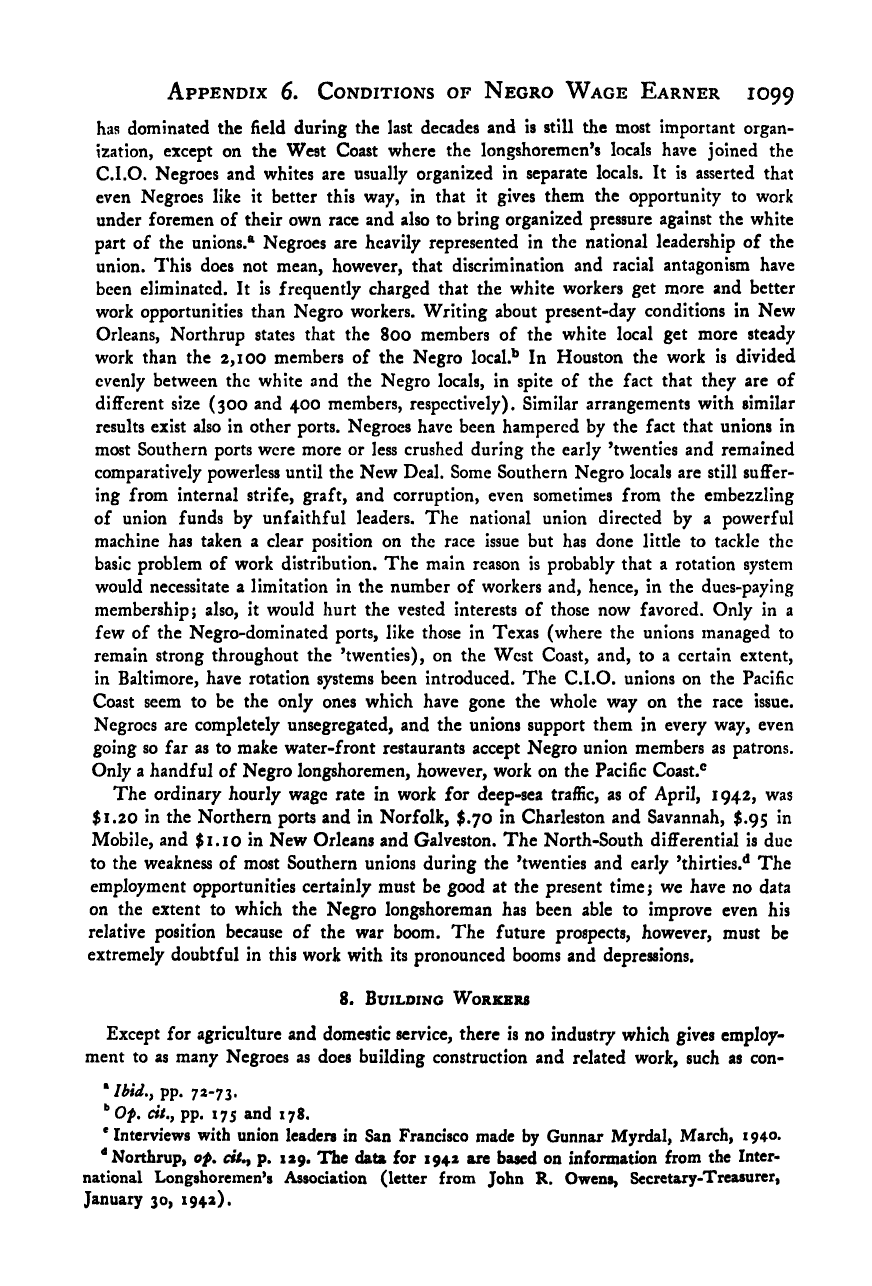Note: Gunnar Myrdal died in 1987, less than 70 years ago. Therefore, this work is protected by copyright, restricting your legal rights to reproduce it. However, you are welcome to view it on screen, as you do now. Read more about copyright.
Full resolution (TIFF) - On this page / på denna sida - Appendices - 6. Pre-War Conditions of the Negro Wage Earner in Selected Industries and Occupations - 7. Longshore Work - 8. Building Workers

<< prev. page << föreg. sida << >> nästa sida >> next page >>
Below is the raw OCR text
from the above scanned image.
Do you see an error? Proofread the page now!
Här nedan syns maskintolkade texten från faksimilbilden ovan.
Ser du något fel? Korrekturläs sidan nu!
This page has never been proofread. / Denna sida har aldrig korrekturlästs.
Appendix 6. Conditions of Negro Wage Earner 1099
has dominated the field during the last decades and is still the most important organ-
ization, except on the West Coast where the longshoremen’s locals have joined the
C.I.O. Negroes and whites are usually organized in separate locals. It is asserted that
even Negroes like it better this way, in that it gives them the opportunity to work
under foremen of their own race and also to bring organized pressure against the white
part of the unions.*^ Negroes are heavily represented in the national leadership of the
union. This does not mean, however, that discrimination and racial antagonism have
been eliminated. It is frequently charged that the white workers get more and better
work opportunities than Negro workers. Writing about present-day conditions in New
Orleans, Northrup states that the 800 members of the white local get more steady
work than the 2,100 members of the Negro local.’’ In Houston the work is divided
evenly between the white and the Negro locals, in spite of the fact that they are of
different size (300 and 400 members, respectively). Similar arrangements with similar
results exist also in other ports. Negroes have been hampered by the fact that unions in
most Southern ports were more or less crushed during the early ’twenties and remained
comparatively powerless until the New Deal. Some Southern Negro locals are still suffer-
ing from internal strife, graft, and corruption, even sometimes from the embezzling
of union funds by unfaithful leaders. The national union directed by a powerful
machine has taken a clear position on the race issue but has done little to tackle the
basic problem of work distribution. The main reason is probably that a rotation system
would necessitate a limitation In the number of workers and, hence, in the dues-paying
membership j
also, it would hurt the vested interests of those now favored. Only in a
few of the Negro-dominated ports, like those in Texas (where the unions managed to
remain strong throughout the ’twenties), on the West Coast, and, to a certain extent,
in Baltimore, have rotation systems been introduced. The C.I.O. unions on the Pacific
Coast seem to be the only ones which have gone the whole way on the race issue.
Negroes are completely unsegregated, and the unions support them in every way, even
going so far as to make water-front restaurants accept Negro union members as patrons.
Only a handful of Negro longshoremen, however, work on the Pacific Coast.®
The ordinary hourly wage rate in work for deep-sea traffic, as of April, 1942, was
$1.20 in the Northern ports and in Norfolk, $.70 in Charleston and Savannah, $.95 in
Mobile, and $1.10 in New Orleans and Galveston. The North-South differential is due
to the weakness of most Southern unions during the ’twenties and early ’thirties.^ The
employment opportunities certainly must be good at the present time; we have no data
on the extent to which the Negro longshoreman has been able to improve even his
relative position because of the war boom. The future prospects, however, must be
extremely doubtful in this work with its pronounced booms and depressions.
8. Building Workers
Except for agriculture and domestic service, there is no industry which gives employ-
ment to as many Negroes as does building construction and related work, such as con-
^ Ibid., yip. 72-73.
Of. cit., pp. 175 and 178.
* Interviews with union leaders in San Francisco made by Gunnar Myrdal, March, 1940.
^Northrup, of. cit., p. 129. The data for 1942 are based on information from the Inter-
national Longshoremen’s Association (letter from John R. Owens, Secretary-Treasurer,
January 30, 1942).
<< prev. page << föreg. sida << >> nästa sida >> next page >>